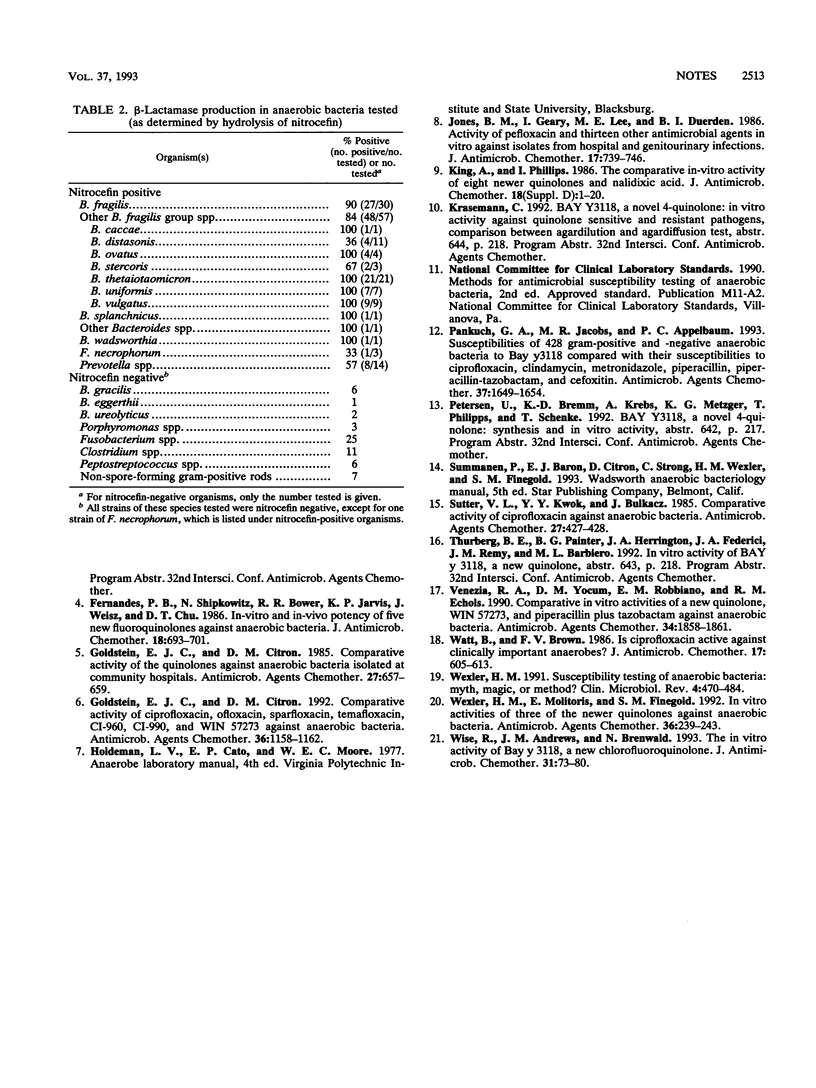Abstract
The antimicrobial activity of a new quinolone, Bay Y3118, was determined against 326 strains of anaerobic bacteria and compared with the activities of ampicillin-sulbactam, cefotetan, clindamycin, imipenem, metronidazole, and sparfloxacin. The National Committee for Clinical Laboratory Standards-approved Wadsworth agar dilution technique with Brucella-laked blood agar was used throughout the study. Breakpoints used to determine the percent susceptible were 2 micrograms/ml for Bay Y3118 and sparfloxacin, 4 micrograms/ml for clindamycin, 8 micrograms/ml for imipenem, 16 micrograms/ml for metronidazole and ampicillin-sulbactam, and 32 micrograms/ml for cefotetan. Species tested included Bacteroides fragilis (57 strains), other B. fragilis group species (79 strains), Bacteroides gracilis (10 strains), other Bacteroides spp. (9 strains), Prevotella spp. (30 strains), Porphyromonas spp. (9 strains), Fusobacterium spp. (36 strains), Bilophila wadsworthia (14 strains), Clostridium spp. (36 strains), Peptostreptococcus spp. (20 strains), and gram-positive non-spore-forming rods (26 strains). Bay Y3118 inhibited all but 1 of 326 anaerobic bacteria tested at the breakpoint level or lower.
Full text
PDF




Selected References
These references are in PubMed. This may not be the complete list of references from this article.
- Clarke A. M., Zemcov S. J. Comparative in vitro activity of lomefloxacin, a new difluoroquinolone. Eur J Clin Microbiol Infect Dis. 1989 Feb;8(2):164–168. doi: 10.1007/BF01963905. [DOI] [PubMed] [Google Scholar]
- Fernandes P. B., Shipkowitz N., Bower R. R., Jarvis K. P., Weisz J., Chu D. T. In-vitro and in-vivo potency of five new fluoroquinolones against anaerobic bacteria. J Antimicrob Chemother. 1986 Dec;18(6):693–701. doi: 10.1093/jac/18.6.693. [DOI] [PubMed] [Google Scholar]
- Goldstein E. J., Citron D. M. Comparative activity of ciprofloxacin, ofloxacin, sparfloxacin, temafloxacin, CI-960, CI-990, and WIN 57273 against anaerobic bacteria. Antimicrob Agents Chemother. 1992 May;36(5):1158–1162. doi: 10.1128/aac.36.5.1158. [DOI] [PMC free article] [PubMed] [Google Scholar]
- Goldstein E. J., Citron D. M. Comparative activity of the quinolones against anaerobic bacteria isolated at community hospitals. Antimicrob Agents Chemother. 1985 Apr;27(4):657–659. doi: 10.1128/aac.27.4.657. [DOI] [PMC free article] [PubMed] [Google Scholar]
- Jones B. M., Geary I., Lee M. E., Duerden B. I. Activity of pefloxacin and thirteen other antimicrobial agents in vitro against isolates from hospital and genitourinary infections. J Antimicrob Chemother. 1986 Jun;17(6):739–746. doi: 10.1093/jac/17.6.739. [DOI] [PubMed] [Google Scholar]
- King A., Phillips I. The comparative in-vitro activity of eight newer quinolones and nalidixic acid. J Antimicrob Chemother. 1986 Nov;18 (Suppl 500):1–20. doi: 10.1093/jac/18.supplement_d.1. [DOI] [PubMed] [Google Scholar]
- Pankuch G. A., Jacobs M. R., Appelbaum P. C. Susceptibilities of 428 gram-positive and -negative anaerobic bacteria to Bay y3118 compared with their susceptibilities to ciprofloxacin, clindamycin, metronidazole, piperacillin, piperacillin-tazobactam, and cefoxitin. Antimicrob Agents Chemother. 1993 Aug;37(8):1649–1654. doi: 10.1128/aac.37.8.1649. [DOI] [PMC free article] [PubMed] [Google Scholar]
- Sutter V. L., Kwok Y. Y., Bulkacz J. Comparative activity of ciprofloxacin against anaerobic bacteria. Antimicrob Agents Chemother. 1985 Mar;27(3):427–428. doi: 10.1128/aac.27.3.427. [DOI] [PMC free article] [PubMed] [Google Scholar]
- Venezia R. A., Yocum D. M., Robbiano E. M., Echols R. M. Comparative in vitro activities of a new quinolone, WIN 57273, and piperacillin plus tazobactam against anaerobic bacteria. Antimicrob Agents Chemother. 1990 Sep;34(9):1858–1861. doi: 10.1128/aac.34.9.1858. [DOI] [PMC free article] [PubMed] [Google Scholar]
- Watt B., Brown F. V. Is ciprofloxacin active against clinically important anaerobes? J Antimicrob Chemother. 1986 May;17(5):605–613. doi: 10.1093/jac/17.5.605. [DOI] [PubMed] [Google Scholar]
- Wexler H. M., Molitoris E., Finegold S. M. In vitro activities of three of the newer quinolones against anaerobic bacteria. Antimicrob Agents Chemother. 1992 Jan;36(1):239–243. doi: 10.1128/aac.36.1.239. [DOI] [PMC free article] [PubMed] [Google Scholar]
- Wexler H. M. Susceptibility testing of anaerobic bacteria: myth, magic, or method? Clin Microbiol Rev. 1991 Oct;4(4):470–484. doi: 10.1128/cmr.4.4.470. [DOI] [PMC free article] [PubMed] [Google Scholar]
- Wise R., Andrews J. M., Brenwald N. The in-vitro activity of Bay y 3118, a new chlorofluoroquinolone. J Antimicrob Chemother. 1993 Jan;31(1):73–80. doi: 10.1093/jac/31.1.73. [DOI] [PubMed] [Google Scholar]


